Einstein had 18th century dynamo Michael Faraday’s portait on his desk, and you can see why (spot the difference). I remember doing in school Faraday’s laws of induction (of a magnetic coil) where you hold your right hand out with thumb and first two fingers all at right angles. That gives directions of current, magnetic lines and movement. Hey presto, the modern age of solenoid sorcery we are all in.
There’s cast-iron proof the ancients knew electroplating. It seems to have been occasionally used for gilding (the lost battery of Khujut Rabu in Iraq), and this description is from Agastya Samhita
“Place a well-cleaned copper plate in an earthenware vessel. Cover it first by copper sulfate and then by moist sawdust. After that, put a mercury-amalgamated zinc sheet on top of the sawdust to avoid polarization. The contact will produce an energy known by the twin name of Mitra-Varuna. Water will be split by this current into Pranavayu and Udanavayu. A chain of one hundred jars is said to give a very effective force.”
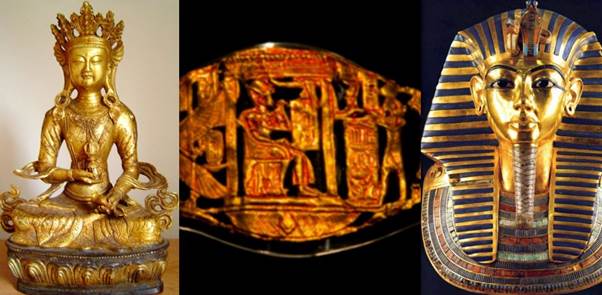
Now, if you go back to Tales of Faith 10, where I say everything in nature is empirical, we see it, this verifies it. You can easily assume the ancients observed metals in containers and, through experimenting, discerned these properties. They then go into a practice of tradition that societies will keep records of, as in India.
So, what’s the difference with Faraday in the early 19th century? The answer has to be Francis Bacon (Tales of Faith 4) who introduced empirical reason to research around 1600. Yes, but this is an empiricism of logic: Faraday had to invent the solenoid or cylinder of wound metal in order to detect magnetic lines and deduce his laws.
There are two empiricisms; one of natural observation (ancient electrolysis), one of logic. When Faraday discovered his laws, he also invented the solenoid. A solenoid is pure geometry (a cylinder). And everything else follows. It’s obviously the age of very precise geometry, and Einstein is no different; there’s no escape from geometry as it’s a fact of nature.
What “they” do is assume facts are everything, even if light is only half of reality. I know that sounds simplistic to say that darkness is the absence of light: so okay, I happen to think reality is simple because observation tells you so. In a world of fact, nothing is balanced and proportionate, main reason being the sun is not enough to provide fertility.
Also needed are earth (loam), water and coolness – the forest floor of Darkwood. With fertility comes magic, gloom, enchanted maidens and the land of faerie; the enchanted tales of Red Sonja by Clair Noto - #2 set in Venzia, #s 3-6 the twinned cities of Athos and Zotoz, #s 7-13 Skranos and the tree-bound palace of Apah Alah. The land of faerie is unsettling, there is a reeking closeness and almost incestuousness. BWS’s glamorous study for Artemis and Apollo captures this romantic decadence
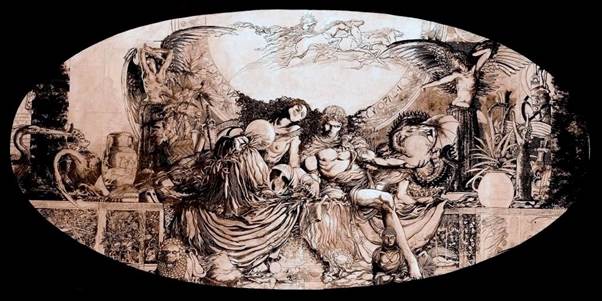
(Tales of Faith 9).
How can glamour be reeking with incestuous closeness? For the same reason a rose has murderous briars! There is blood and death everywhere in nature. Man makes empirical rules to cleanse himself – see the sanitary or Mosaic tradition Tales of Faith 10. Nature is dirty, nature is bloody, and empirically-speaking, Man makes traditions to cleanse himself. Figurative meaning; hunter, farmer, herder, life on a range, deep cleansing with oils (Pictorial 21).
If all that is empirical tradition, it’s the very opposite of Bacon’s empirical reason. How so? Because abstract reason or logic isn’t empirical – Bacon recognized this danger, see Tales of Faith 10 again. The most blatant example is CERN (Tales of Faith 6). This is a completely geometrical device to detect quanta. Not only that: how are the data observed? It has to be with electronic monitors – that’s what you see the guys staring at!
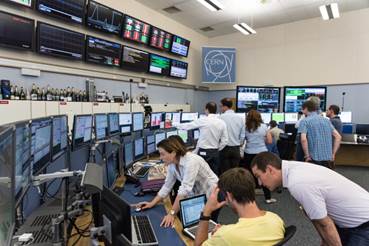
“Is that Cerberus?” Tales of Faith 11
But an electronic monitor has to obey Faraday’s laws of induction (the right-hand rule). In other words, they are in a geometric universe, and that is what they are detecting! “They” call it nature, but that’s only true if nature is geometrical.
There are higher truths of balance and proportion. Artemis and Apollo; the sun is only half of reality. Half of something might have an appearance of reality, but it’s still false (the false Apollo – see passim). Not only false but rotten. It’s hubris, and circling round the world of rational planning, infusing it with psychoses that spring from ego-lust, are the dark faerie of human desires. We cannot deny them, we are part of the land of eternal regeneration, Artemis and the lunar cycle. The land of bewitchment that is crowded with fertility and teaming with blood-sacrifice.
But before going full-blooded into Hyboria –the Skranos saga of Clair Noto from Red Sonja #7 through to 13 – I just happened to pick-up on a review of Weimar painting by Alastair Sooke in DT Maybe he had an off-day, but the sight of blood and mangled corpses actually seemed to cause him upset! This is the dichotomy we’re in today; our lives are so mild and “head-bound” we’re hardly aware of the blood that courses through our veins.
We are ephemeral creatures and death is everywhere – it’s just hidden from us. Go to the fields, see the birds and bugs and bats fighting it out, or the creepy-crawlies underneath. We’re part of that cycle and, empirically-speaking, that is a truth “they” distract us from. And now, heading towards the jewelled gates of Skranos in the uplands of Argos..
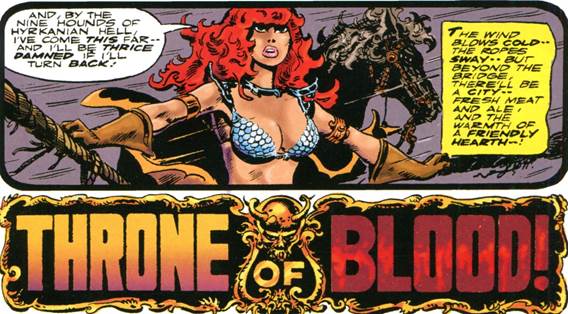
Red Sonja #7 1977 © Red Sonja LLC
..Sonja arrives at the gold-besotted city of Athos in the Argossean heartland in #3, but #2 sees her overlooking the bejewelled port of Venzia – as can be seen from Frank Thorne’s splash – much like the Venice of Clair Noto’s forebears. Ah, Venice, trading empire of Mediterranean seas where religio-culture and art were gloriously independent.
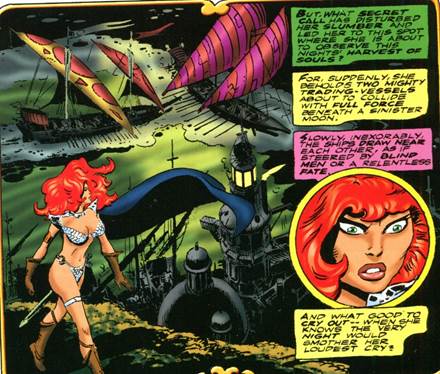
© RS LLC
Noto’s forte is to get into the souls of cities which are run by competing sorcerous factions, rather like you assume Venice was a study in rival trading houses or families. It’s intricate, and even brings in far-off trading, a charmed Khitaian jar to further the aims of the demonic one.
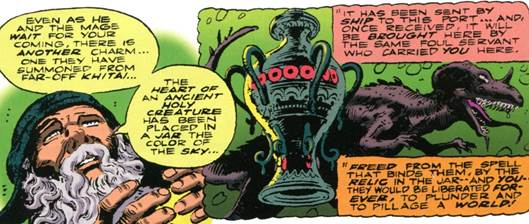
© RS LLC
Trading to make ports prosper and their citizens thrive, developing styles and fashions, a psychic lustre second to none. These fabulous Argossean cities are all very different and have a soul that is worth pursuing even if downright weird! There is something there, a psychic content and a physical allure, and these pull you into her stories of exiled heirs, strung-up queens and dens of iniquity.
Trade is meant to strengthen and provide for points-of-call for exotic ware. What is it about the modern world that makes every point-of-call the same? Put it another way; what is it that makes things different? Town-and-country; the physical content of a place that is distinctive. The land-geography, the seaways and tributaries. The way Hyboria is depicted is often very geographical, and Noto makes good use of this in the Skranos storyline.
There are also physically alluring phrases and scents, like
It seems like the heavens shake and moan – and all within hearing distance bend like the palms of Shem in hot desert winds. #5 “Master of the Bells”
Hyboria is what you might remember from school geography lessons or maybe Bible studies: pictorial maps and picturesque peoples, names and places. It’s more or less the simple and physical presence of places that makes things different. This connects us to our own physicality and the history of Man as a hunter, a coordinated wanderer and warrior, strengthening the psyche.
Everything in modernity conspires not to be adventurously physical and not to have an introspective content/psyche; hence, to become the same. Our reality is much more mental than it has been in the past but –Hyborian Bridge 12 –has the effect where you stare at a monitor, in effect staring at nothing.
Because the mental has no empirical truth, it is easily fooled by so-called data that has no meaning (the latest craze I saw was “QAnon”). As I’ve said previously (Weird 11 “The Enchantment”), meaning is figures in a landscape and the symmetry of things (epistemology). Rituals are places of power (ontology).
The Hyborian trade-routes and power-alliances and rivalries in cities are very “thing-like”. They are intriguing and odd and make for fascinating stories and elaborate objets d’art. “Thingness” is absent from the modern world because “they” don’t think it exists; they are basically fooled by their data. The egocentric mind, empirically empty, stares at its monitor in rapturous delusion.
Home







